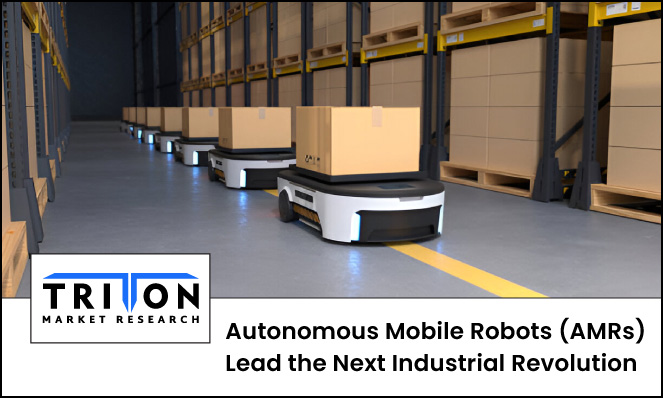



23, September 2024

Is it possible to imagine a world where robots independently perform complex tasks in busy warehouses and easily adapt to dynamic environments? The answer is YES! Today, Autonomous Mobile Robots (AMRs) are now outpacing traditional Automated Guided Vehicles (AGVs) with their advanced autonomy and adaptability.
The latest robotics industry trends show that AMR adoption is accelerating across various sectors. For instance, the International Federation of Robotics (IFR) reported around a 40% increase in the global adoption of AMRs in public environments by the end of 2023.
Thus, being at the forefront of the robotics revolution, AMR technology has been successfully transforming industries by optimizing their work efficiency. By reducing costs and ensuring higher levels of safety, AMRs are making a significant impact from warehouses to healthcare and logistics sectors. Evidently, as businesses strive to stay competitive, the adoption of AMR technology is not just a trend but also a necessity for future growth and innovation.
Let us explore the real potential of deploying autonomous mobile robots.
Autonomous Mobile Robots (AMRs) can integrate various components to achieve utmost functionality. Essential AMR components include AMR sensors like LiDAR, cameras, ultrasonic sensors, and IMUs. Sensors are the make-or-break component for autonomous mobile robots as they serve as the eyes and ears for them.
For instance, LiDAR creates detailed environmental maps, while cameras aid in object recognition and situational awareness. Ultrasonic sensors and IMUs assist in obstacle detection and maintaining stability, respectively.
Most importantly, AMRs operate based on in-build instructions, which enables these robots to perform tasks efficiently and autonomously. Here are four key principles:
Environmental mapping: This involves gathering data to create detailed, up-to-date maps of the surroundings.
Localization: AMR uses sensor data to track its position within this map, ensuring accurate navigation.
Path planning: AMRs are installed with algorithms that determine optimal routes, continuously adjusting in real time to accommodate dynamic changes.
Obstacle avoidance: These robots can detect and navigate around obstacles, ensuring smooth operation even in complex environments.
Streamlining workflows: AMRs optimize processes by automating repetitive tasks, such as transporting materials and managing inventory, which streamlines workflows. This automation reduces human error and accelerates task completion, leading to a more productive work environment.
Safety: Equipped with advanced sensors and real-time monitoring systems, these robots can navigate complex environments while avoiding collisions with obstacles and humans. This capability significantly reduces the risk of workplace accidents, contributing to a safer and more secure environment for employees.
Cost Reduction: By automating labor-intensive tasks, businesses can lower labor costs and reduce operational expenses resulting from human errors. Additionally, the reduction in downtime and maintenance costs further contributes to AMR cost benefits.
Flexible automation: With scalable solutions, AMRs can be easily reconfigured to adapt to changing business needs and scale up operations without major infrastructure changes. This adaptability ensures that businesses can respond quickly to market demands and expand their operations.
Autonomous Mobile Robots (AMRs) are revolutionizing multiple sectors by enhancing operational efficiency and work productivity.
Logistics and Warehousing: AMRs in logistics and warehousing are focal on ensuring workplace safety, order fulfillment, inventory management, and goods-to-person systems. For example, new Amazon robots, Sequoia and Digit, enhance workplace safety and speed up deliveries. Sequoia accelerates inventory processing at fulfillment centers by up to 75%, enabling quicker listing of items on Amazon.com. It also reduces order processing time by 25%, boosting shipping predictability and expanding Same-Day and Next-Day delivery options.
Several AMR startups in logistics and warehousing operations are making their mark. For instance, MuL Technologies, a US-based startup, provides mobile autonomous robotic carts designed for use in manufacturing, warehousing, and logistics. Likewise, the Japanese startup LexxPluss specializes in automated transfer robots tailored for warehouse operations.
Manufacturing: Autonomous robots in manufacturing play a crucial role in optimizing production lines and material handling. They automate the movement of components between workstations, support kitting operations by delivering necessary parts to assembly areas, and improve overall workflow efficiency. This automation reduces manual labor and speeds up production cycles.
Healthcare: Healthcare is another area benefiting from AMR technology. AMRs in healthcare are used for drug delivery within hospitals, managing the supply chain of medical supplies, and transporting patients or samples between departments. Many hospitals have successfully implemented AMRs for routine medication delivery, freeing up valuable staff time for direct patient care.
In Mexico, the startup Roomie has developed an autonomous robot called RoomieBot to assist medical staff with high-risk COVID-19 patients. RoomieBot performs triage by measuring patient’s temperature and blood oxygen levels and collecting their medical history upon arrival at the hospital. It utilizes Intel-based technology, featuring AI algorithms powered by the Intel Movidius Vision Processing Unit (VPU), 8th Gen Intel NUCs, and Intel RealSense cameras.
Emerging Applications: Emerging applications for AMRs include retail and agriculture. Autonomous robots in retail could automate restocking and inventory checks, while in agriculture, they offer potential for tasks like planting and harvesting, reflecting the technology’s versatility and growing impact across diverse sectors.
As we look ahead, Autonomous Mobile Robots (AMRs) are set to revolutionize industries with groundbreaking technological advancements and shifting market dynamics. Emerging AMR technologies such as advanced AI, enhanced sensors, and improved battery systems are set to further elevate its capabilities. Innovations like 5G connectivity will enable real-time data transmission, while more sophisticated machine learning algorithms will enhance decision-making and autonomous navigation. Currently, the rise of e-commerce and the need for efficient supply chain management are pushing businesses to integrate AMRs into their operations. As companies seek to optimize productivity and reduce costs, AMRs offer scalable and flexible solutions that meet these evolving demands.

Prevalent cases of terrorist attacks in today’s world is increasing the need for severe standards of security for public safety, and the global market for biometric technology scrupulously accommoda..
Prevalent cases of terrorist attacks in today’s world is increasing the need for..